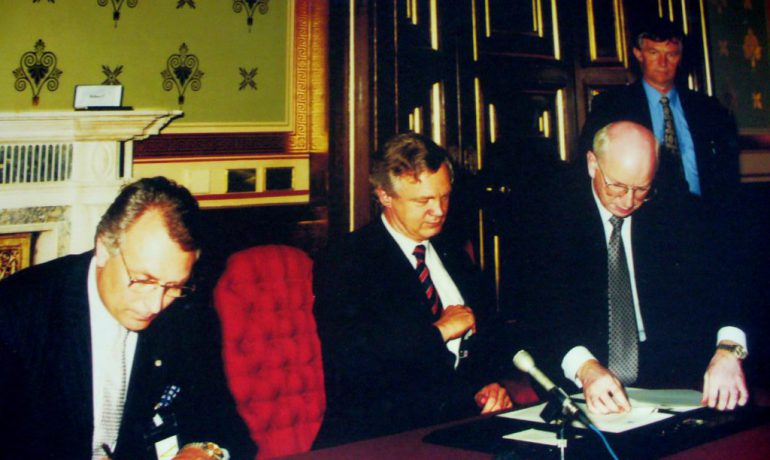25 years ago, on July 20, 1995, in London, Minister of State at the British Foreign Office David Davis and the Ambassador of Ukraine Serhiy Komisarenko exchanged diplomatic notes on the transfer of the Antarctic Faraday Station to Ukraine. This day is the starting point of Antarctic history of independent Ukraine.
“I consider the day of signing the memorandum to be one of the turning points for Ukrainian science. We can say that it was on this day that a unique window of opportunity began to open, thanks to which Ukrainian scientists can participate in scientific research of global importance, in international projects and consortia without emigrating from their homeland. On this truly festive day, I congratulate all Ukrainian polar explorers and especially those who are now working at Akademik Vernadsky station – members of the 25th Ukrainian Antarctic Expedition,” says Evgen Dykyi, director of the National Antarctic Scientific Center.
We recall that 25 years ago the British government transferred the Antarctic Faraday station to Ukraine free of charge, along with scientific equipment.
This event was preceded by an extensive diplomatic work, which was masterfully carried out by the first Ambassador of the independent Ukraine to the United Kingdom, Academician Serhiy Komisarenko, who was then called the “godfather” of Akademik Vernadsky station.
“Since the 1950s, Ukraine has participated in the exploration of Antarctica as part of Soviet Antarctic expeditions. However, when the USSR collapsed, Russia declared itself its legal successor and refused to transfer one of about ten Soviet stations to Ukraine,”says Serhiy Komisarenko.
In 1992-1993, the UK decided to sell one of its first stations existed on Galindez Island since the 1940s – Faraday station. Several countries, in particular South Korea, were interested in this scientific base. “I wrote letters to all influential state institutions of Ukraine that it is worth purchasing a station on this promising continent. At the same time, realizing the problems with the Ukrainian budget, I began during meetings with Foreign Minister David Davis, whom I knew well, to push forward the idea of whether the United Kingdom could help the young country with the purchase of the Faraday station,” recalls Serhiy Komisarenko. According to him, the attitude of the British establishment towards Ukraine was very positive, and London began to consider this possibility.
In 1994, with the support of the United Kingdom, Ukraine became a member of the Scientific Committee on Antarctic Research. “Ukraine was admitted to SCAR despite the fact that at that time it did not yet have its own station in Antarctica, “Komisarenko emphasizes.
The UK wanted the next station owner to have sufficient scientific potential to continue the research started at Faraday. That is why the final decision on the fate of the station was preceded by a trip of delegations of the British Antarctic Survey to Ukraine and acquaintance with scientists from the institutes of the NASU in Kyiv and Kharkiv.
This condition formed the basis of the Memorandum of Understanding signed on July 20, 1995 by the head of the newly created Antarctic Center of Ukraine, Academician Petro Gozhyk, and director of the BAS, Barry Heywood. The fruitful cooperation between NASC and BAS continues to this day.
Ukrainian scientists continue a number of scientific studies initiated by British colleagues. Thus, the hydrometeorological research started at the station in 1947 was not interrupted for a day. Also, Ukrainian scientists continue to study the ozone hole – a phenomenon that was first discovered in the 1980s by the British at Faraday station.
A memorandum of cooperation between the Antarctic Center of Ukraine and BAS was signed on the same day with the memorandum on the free transfer of Faraday station to Ukraine.
On November 28, 1995, the First Ukrainian Antarctic Expedition, headed by Gennady Milinevsky, arrived on Galindez Island and worked with British colleagues for almost three months, studying the station and learning from the experience. On February 6, 1996, the National Flag of Ukraine was raised, and from that day the Ukrainian history of the station began, which was named after the outstanding scientist, founder of the Ukrainian Academy of Sciences, Volodymyr Vernadsky.
Photos from the NASC archive: Ambassador Plenipotentiary of Ukraine to the United Kingdom Serhiy Komisarenko (left) and British Foreign Minister David Davis sign a Memorandum on the transfer of Faraday station to Ukraine. July 20, 1995.


